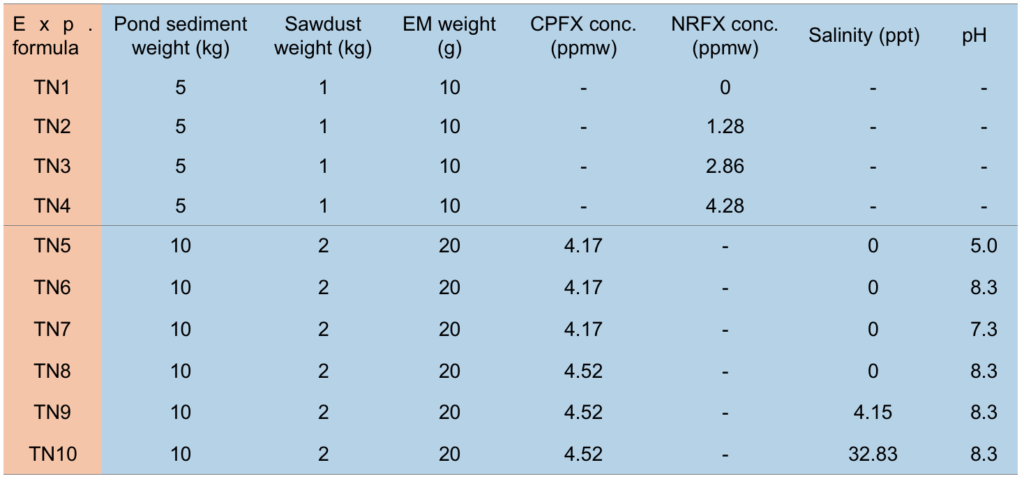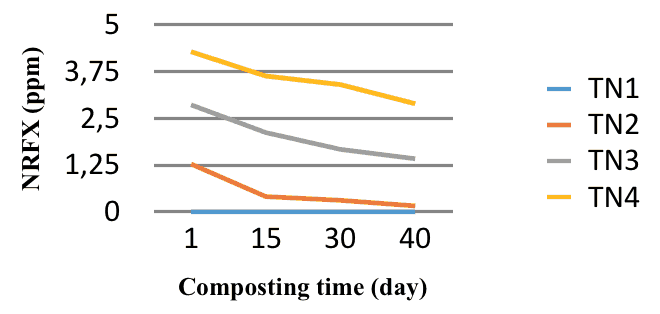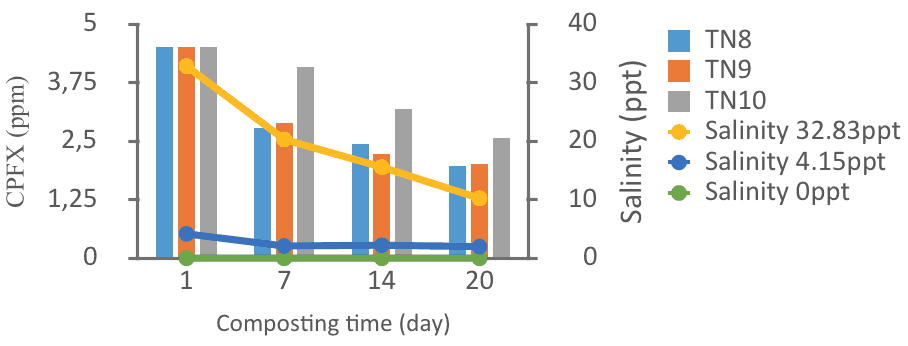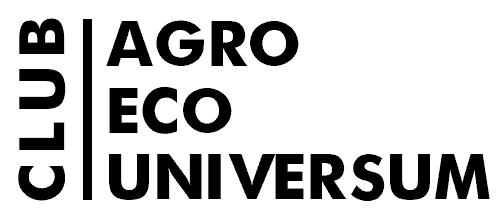Shrimp farming in Vietnam

In shrimp farming, antibiotics are commonly used to prevent and eliminate diseases in their shrimps, which might lead to the increase of antibiotic residues in shrimp, and the accumulation of the used antibiotics in pond sediment. They might have harmful impacts on the environment and human health if they are not treated properly. Recently, inappropriate planing of shrimp farming in many coastal areas has resulted in the reduction of water quality and post larvaes. Farmers use a variety of antibiotics by mixing with aquafeed to prevent disease and cure for affected shrimp. Antibiotics are mixed with shrimp food that can affect the quality of shrimp and lead to the existence of antibiotic residues in shrimp pond water and sediment.
SHRIMP POND SEDIMENT COMPOSTING PROCESS
Composting feed
Experimental formula for ciprofloxacin decomposition experiments

Chemical and physical characteristics of the pond sediment
Chemical and physical compounds in the pond sediment

Variation of temperature, pH and moisture during the composting
Temperature: During the compositing processes, temperature of the compost piles increased rapidly during the first 20 days, from 25 to 55 °C, and then decreased to 35-40 °C.
pH: pH values ranged from 6.2 to 8.3 (neutral) after 40 day composting. During the first 5 days and from day 15 to day 20, the pH values decreased from 8.0 to 6.0. That is because the microorganism began to rapidly decompose the organic substances and produced the organic acids, what reduced the pH.
Moisture: the moisture of the piles fluctuated largely during 40 days of composting, in the range of 50.8–77.0%. This moisture was suitable for microorganisms to grow. Moisture tended to decrease by composting times.
ANTIBIOTIC REMOVAL FROM SHRIMP POND SEDIMENT DURING COMPOSTING
Decomposition of Norfloxacin (NRFX) antibiotic during composting
The experiments were conducted at different initial concentrations of Norfloxacin (NRFX). During the first 15 days, significant decrease in the concentration of NRFX in all three experiments was found that may because this period microorganisms grew sharply, and some bacteria were able to produce enzymes that degrade antibiotics. The reduction level of NRFX in TN2, TN3, TN4 after 40 days of composting corresponded to 87.5, 50.3, and 32.5%, respectively.
Effects of salinity and pH on ciprofloxacin (CPFX) removal during composting process
 Effect of salinity: Salinity tended to decrease rapidly during the first 20 days. Reduction of CPFX concentrations in the compost piles was the same and dropped sharply in the first 7 days. The findings indicate that high salinity will slow down the decomposition of CPFX. CPFX removal efficiency of the experiments reached 56, 55 and 43% with initial CPFX content of 0; 4.15 and 32.83 ppt, respectively.
Effect of salinity: Salinity tended to decrease rapidly during the first 20 days. Reduction of CPFX concentrations in the compost piles was the same and dropped sharply in the first 7 days. The findings indicate that high salinity will slow down the decomposition of CPFX. CPFX removal efficiency of the experiments reached 56, 55 and 43% with initial CPFX content of 0; 4.15 and 32.83 ppt, respectively.
 Effect of pH: During the first 20 days, pH of all piles tended to decrease. The main cause for that situation is that the microorganism grew rapidly in the pH ranging from 5.5 to 8.5. At these values, the microorganisms broke down the most organic matters and produced a lot of organic acids, so the pH drop ped sharply.
Effect of pH: During the first 20 days, pH of all piles tended to decrease. The main cause for that situation is that the microorganism grew rapidly in the pH ranging from 5.5 to 8.5. At these values, the microorganisms broke down the most organic matters and produced a lot of organic acids, so the pH drop ped sharply.
The CPFX removal efficacy seem to be better in neutral and weak base, attained 54; 55 and 45% at pH of 8.3; 7.3 and 5.0, respectively
Characterization of compost
 After 40 days of composting, the moisture of the mixture significantly decreased, HC content ranged from 15.7 to 18.8%, lower than standards for organic fertilizer quality (≥ 20%), however it met standard for mineral-organic compost. Nitrogen content and C/N ratio both met mineral-organic fertilizer quality standards regulated by the Vietnam Ministry of Agriculture and Rural Development.
After 40 days of composting, the moisture of the mixture significantly decreased, HC content ranged from 15.7 to 18.8%, lower than standards for organic fertilizer quality (≥ 20%), however it met standard for mineral-organic compost. Nitrogen content and C/N ratio both met mineral-organic fertilizer quality standards regulated by the Vietnam Ministry of Agriculture and Rural Development.
Full text:
Nguyen Dac Kien1, Tran Thi Loan, Nguyen Quang Trung, Le Van Nhan, Nguyen Thi Ha Removal of fluoroquinolone antimicrobials (ciprofloxacin and norfloxacin) from shrimp pond sediment during composting // Vietnam Journal of Science and Technology 56 (2C) (2018) 178-185
